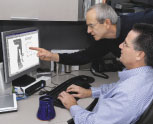Working Model 2D
2D Dynamic Motion Simulation

Army Research Laboratory Masters Launch Dynamics
Recently, the Jet Propulsion Laboratory (JPL) challenged the Army Research Laboratory’s Advanced Munitions Concepts Branch (AMCB) to create conceptual designs for launching puck-shaped sensor-carrying projectiles from a low Earth-orbiting satellite or sounding rocket host vehicle. The projectile, or "sensorcraft," is designed to study the Earth’s magnetic fields.
The Army Research Laboratory’s Weapons and Materials Directorate, located at the Aberdeen Proving Ground in Maryland, conducts ballistics, propulsion and flight, materials, and other types of research for the Army, other governmental agencies, and contractors. AMCB specializes in developing low-cost, highly shock resistant, micro-electromechanical in-flight telemetry/measurement instrumentation for munition systems. This work requires mechanical and electronics packaging design and analysis as well as prototype fabrication and testing.
Among the Laboratory’s clients is the JPL. Managed for NASA by the California Institute of Technology, the JPL is the lead U.S. center for robotic exploration of the solar system. JPL spacecraft have visited all known planets except Pluto. In addition to its work for NASA, JPL conducts tasks for a variety of other federal agencies. In addition, JPL manages the worldwide Deep Space Network, which communicates with spacecraft and conducts scientific investigations from its complexes in California’s Mojave Desert.
The Simulation and Design Challenge
JPL provided John Condon, an AMCB mechanical engineer, with certain criteria for the sensorcraft, including its weight, shape, and geometry. The sensorcraft measures six centimeters in diameter by two centimeters in width, similar in appearance to a hockey puck. JPL stipulated that the sensorcraft would launch from a satellite or other launch vehicle.
Simulation Replaces Hand Calculations
Prior to joining the AMCB in October 1996, Condon had not used a simulation tool for dynamics and kinematics. However, he decided he needed such a tool for this branch because it deals extensively with mechanisms.
"Without a simulation tool we would have had to resort to “back of the envelope” hand calculations and building detailed physical models," Condon says. "The labor costs and the time required to complete extensive hand calculations and build detailed physical models were prohibitive. Without a simulation tool, it would have taken about two months for this project alone."
Condon evaluated Working Model® from Design Simulation Technologies and Adams software. Condon selected Working Model after evaluating its cost and capabilities. Today, Condon runs Working Model 2D. In addition to Working Model, he uses AutoCAD® for design and Algor for structural finite element stress analysis.
Launch Dynamics
Recently, Condon completed Phase I conceptual design of a canister-shaped and drive wheel-based launcher that will deploy JPL’s sensorcraft. He used Working Model 2D 4.0.1 to simulate the indexing or holding, advancing and releasing of the sensorcraft as they traveled from the storage canister to the drive wheels of the launcher just before being ejected by the friction drive wheels.
According to Condon, Working Model enabled him to learn about the advancing dynamics—how the sensorcrafts would move through the launcher. He simulated the internal moving parts of the launcher, including the springs, dampers, and a plunger that would push the next sensorcraft into position for launch.
AMCB provided JPL with a detailed conceptual design report and an estimate detailing the costs involved in building a full-scale launcher prototype, based on predictions made by the Working Model software. All together, the launcher would contain approximately 20 components, including the indexing subsystem’s springs, dampers and solenoids.
"The measuring tools inherent in Working Model helped me complete the launcher project," Condon says. "For example, I studied the axial velocities of each sensorcraft as it traveled through the canister. I used the time meter to apply retraction forces for the indexing solenoids and manipulated how fast a sensorcraft was advanced up to the launcher’s primary friction drive wheels by adjusting the spring and damper constraints of the advancement plunger. In the end, the solution I came up with was for the canister to hold 10 to 12 sensorcrafts to be ejected one at a time at about one-second intervals."
"Programs such as Working Model enable us to evaluate our options before we build subscale or full-scale prototypes," Condon concludes. "This saves time and money."

 Quote
Quote Evaluation
Evaluation



